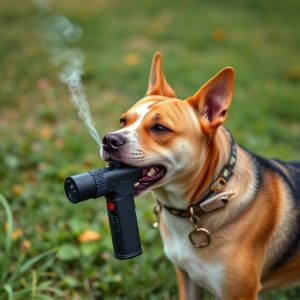Safe Pepper Spray Dog Defense Methods: Creating an Effective Deterrent
Understanding canine behavior is key to implementing effective yet safe pepper spray dog defense met…….
Understanding canine behavior is key to implementing effective yet safe pepper spray dog defense methods. By recognizing triggers like territoriality and protective drives, owners can choose balanced capsaicin-based formulas that discourage aggression without harming pets. Optimal prevention includes regular training, positive reinforcement, and securely storing deterrents. Precise application techniques, focusing on eyes and nose, and building confidence through practice are crucial. Legal and ethical considerations, along with responsible practices like fencing and training, ensure the well-being of dogs while protecting property and loved ones.
Discover the power of safe pepper spray dog defense methods! This comprehensive guide explores effective deterrents for managing canine aggression. We delve into understanding dog behavior, the science behind pepper spray formulas, and creating a balanced mixture for optimal results. Learn application techniques, training tips, and essential legal considerations to ensure ethical use. By implementing these strategies, you can create safer spaces without compromising your pet’s well-being.
- Understanding Dog Behavior and Aggression Triggers
- The Science Behind Pepper Spray Formulas for Dogs
- Creating a Safe and Effective Dog Deterrent Spray
- Application Techniques and Training for Optimal Results
- Legal Considerations and Ethical Use of Pepper Spray on Dogs
Understanding Dog Behavior and Aggression Triggers
Dogs, like any animal, have their own unique behaviors and triggers that can lead to aggression. Understanding these is key when considering safe pepper spray dog defense methods. One of the primary factors is territoriality; dogs often protect their spaces, whether it’s their homes or outdoor areas they frequent. Intruders, whether perceived or real, can set off defensive instincts. Additionally, certain breeds have naturally higher protective drives, making them more prone to aggression if not properly socialized and trained.
Aggression can also be triggered by fear or anxiety. Dogs may react aggressively when feeling threatened or in unfamiliar environments. Some dogs might also display protectiveness towards their owners, especially if they have a strong bond. Knowing these triggers helps pet owners choose appropriate defense methods, such as safe pepper spray, that address the root cause of aggressive behavior while ensuring the well-being and safety of both the dog and potential intruders.
The Science Behind Pepper Spray Formulas for Dogs
The Science Behind Pepper Spray Formulas for Dogs
When it comes to safe pepper spray dog defense methods, understanding the science behind the formula is key. Pepper spray works by stimulating nerve endings in a dog’s eyes and nose, causing temporary blindness, irritation, and discomfort. The active ingredient typically involves capsaicin, the chemical responsible for the heat sensation in chili peppers. However, not all pepper spray formulas are created equal. For dog deterrents, researchers focus on creating balanced blends that are potent enough to discourage aggressive behavior without causing excessive pain or long-term harm.
Safe and effective dog deterrents often incorporate natural ingredients alongside capsaicin to enhance their performance. These may include components like citronella, pepper mint, or other essential oils known for their repellent properties. The right combination ensures the spray remains humane while remaining a powerful deterrent. This scientific approach allows owners to protect their property and loved ones without resorting to harsh chemicals or methods that could cause lasting negative impacts on their furry companions.
Creating a Safe and Effective Dog Deterrent Spray
Creating a safe and effective dog deterrent spray involves balancing potency with safety, as not all pepper sprays are designed for human use around pets. Opt for a formula that’s specifically formulated for animal deterrence, often using capsaicin, the active ingredient in chili peppers, in lower concentrations to minimize risk of harm to your furry friends while still being effective as a deterrent. These dog-specific sprays typically come with specific safety measures and guidelines, ensuring they’re safe to use around animals without causing severe health issues.
When crafting or purchasing a dog deterrent spray, remember that prevention is key. Aim for a product that can be easily carried and applied quickly when needed, such as during walks in unfamiliar areas. Regular training and positive reinforcement should also accompany the use of such sprays, teaching your dog safe boundaries without resorting to unpleasant experiences. Always store any deterrents out of reach and follow all usage instructions carefully to maintain a safe environment for both you and your pet.
Application Techniques and Training for Optimal Results
When using safe pepper spray dog defense methods, proper application techniques are key to achieving optimal results. Aim for the eyes and nose—these sensitive areas can quickly deter an aggressive dog. Hold the can upright, about 10-15 cm away from the target, and activate the spray in quick bursts. Consistent and controlled applications are more effective than long, continuous sprays. It’s crucial to practice these techniques in safe, controlled environments to build confidence and ensure proper usage.
Training your dog to recognize and respond to the scent of pepper spray is equally important. Start by introducing the spray in a positive manner—rewarding calm behavior upon smell exposure. Gradually increase the intensity of the scent, always ending on a positive note. This association will help your dog understand that the scent means no harm but signals the need to stay calm and avoid unnecessary interactions. Regular refresher sessions are beneficial, as dogs’ memories fade over time.
Legal Considerations and Ethical Use of Pepper Spray on Dogs
When considering safe pepper spray dog defense methods, it’s paramount to address legal and ethical considerations. While pepper spray can be an effective deterrent for dogs, its use should be regulated and responsible. Laws regarding pepper spray vary by region, with some areas allowing its use solely for self-defense against humans, while others permit its employment to protect property or livestock. Even in regions where it’s legal, the specific regulations dictate who can purchase and carry pepper spray, as well as under what circumstances it can be deployed.
Ethically, the use of pepper spray on dogs should be a last resort after all non-lethal alternatives have been exhausted. It’s crucial to consider the potential impact on the animal’s welfare, including its health, behavior, and overall well-being. Responsible dog owners and professionals advocate for positive reinforcement training, fencing, and other safe methods to prevent or mitigate problematic behaviors from dogs before resorting to pepper spray.
When it comes to dog deterrent spray, understanding the science behind effective formulas, legal considerations, and proper application techniques is key to utilizing safe pepper spray dog defense methods. By combining knowledge of canine behavior with strategic formula design, we can create tools that deter aggression without causing harm. Remember, responsible use, training, and a holistic approach to addressing aggression are vital for maintaining a peaceful coexistence between humans and their canine companions.


